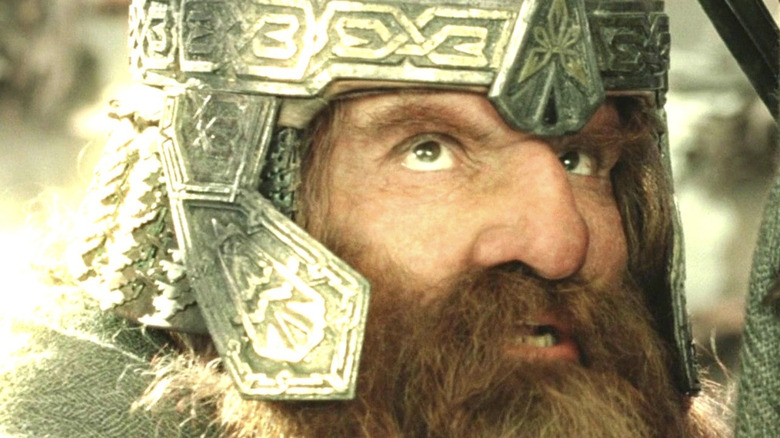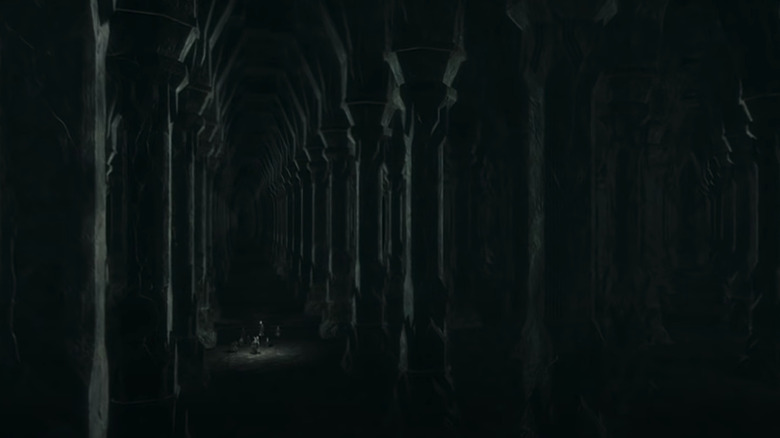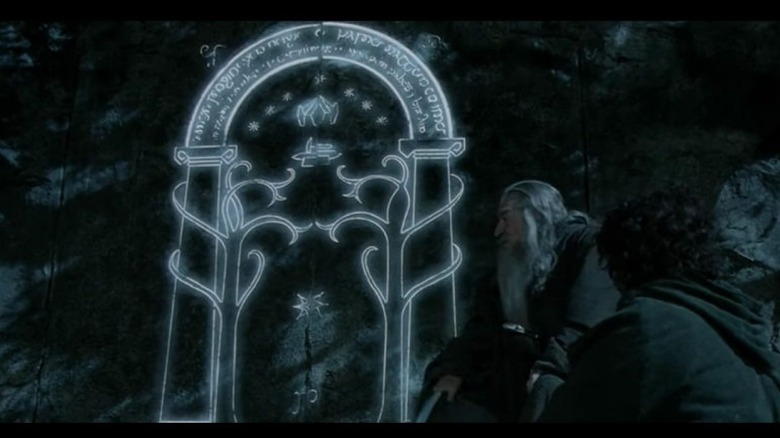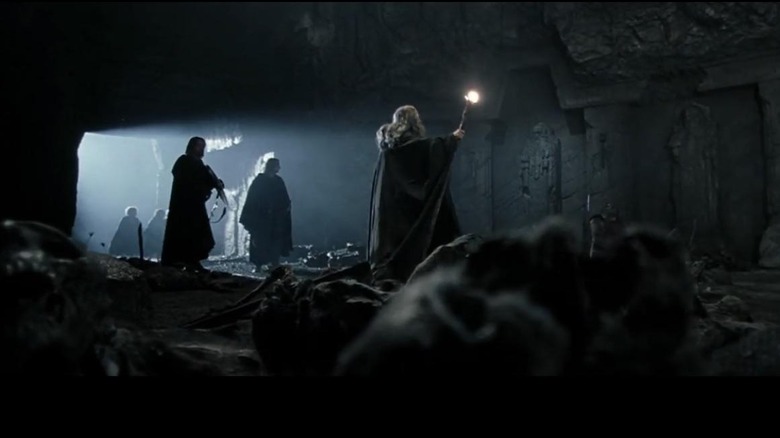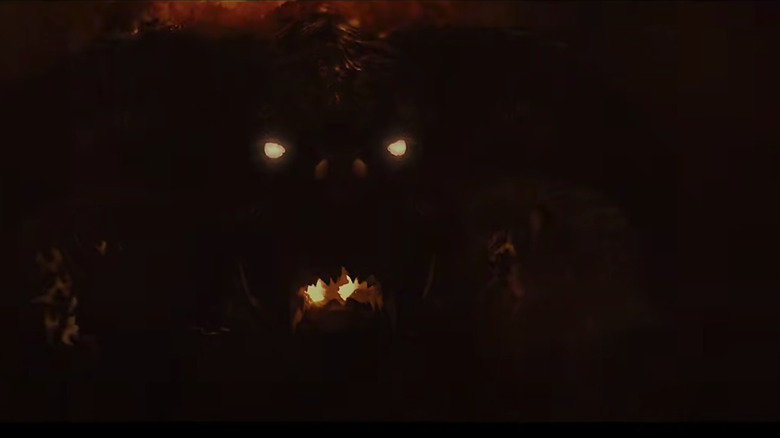The Lord Of The Rings: The History Of Khazad-Dum, Aka Moria, Explained
One of the most harrowing portions of "The Lord of the Rings" trilogy takes place when Gandalf leads the Fellowship of the Ring through the subterranean labyrinth of Moria. Everyone and their mother knows about the journey in the dark, which takes days to complete and ends with a distressing encounter with an army of evil creatures led by a Balrog.
From there, the story moves on as the company escapes the dreadful underground house of horrors and seeks refuge in nearby Lothlorien. Even Gandalf, who stays behind and slays the demon, is reincarnated and heads off to fight Mordor as Gandalf the White. And that's it. That's pretty much the last that we hear about Moria. The Balrog might be gone, but the abandoned Dwarven city falls off the radar and no longer impacts the story in a significant way.
Okay, so that's it then? Taken at face value, Moria feels like little more than a plot point. It's a dangerous obstacle placed in the path of our intrepid heroes, a lightless bump in the road, a monkey wrench tossed in to complicate their journey, a hindrance that ultimately can't stop the fate of Frodo and his companions. But anyone who knows anything about J.R.R. Tolkien's writings knows that nothing — like, nothing — is merely added in to "juice up the plot." Every location, creature, and event in Tolkien's story hints at something bigger — including the dark depths of Moria.
With that said, we've gathered up everything there is to know about the ancient Dwarven mansion and how it came to play such a dark role in the destruction of the One Ring. Here is the history of the Dwarven stronghold of Khazad-dûm, or as it's commonly referred to, Moria.
The greatest Dwarven mansion of them all
The history of Moria goes way back to the earliest days of Tolkien's mythology. At this point, and for most of its history, the underground realm is called, among other things, Khazad-dûm. Moria, which means the "Black Pit," is a nasty name only given to the area later on — you know, when the Dwarves are replaced by a fire-breathing demon. "The Silmarillion" tells us that in its heyday, Khazad-dûm was a stunner. In fact, the book states that "Greatest of all the mansions of the Dwarves was Khazad-dûm...that was afterwards in the days of its darkness called Moria."
The Dwarven city is regularly referred to as a "mansion," indicating that it's a major focal point for the hardy, rock-dwelling people. In fact, Khazad-dûm is the main city of Durin, the oldest of the Fathers of the Dwarves (via Tolkien Gateway) — the seven legendary Dwarves that started the race. Durin finds the area at an undisclosed time during the beginning of the world. In "The Fellowship of the Ring," Gimli explains via song that Durin wanders into the area in the Elder Days when "the world was young, the mountains green, no stain yet on the Moon was seen."
When Durin finds the site, the Dwarven hero sets up shop, and it eventually becomes a densely populated area. The growing city becomes filled with both comfortable living spaces as well as many intricate mines, where the miners extract their prime commodity, mithril. In "The Fellowship of the Ring," Gandalf explains that, "the wealth of Moria was not in gold and jewels...nor in iron...For here alone in the world was found Moria-silver, or true-silver as some have called it: mithril is the Elvish name."
At this early stage in their history, the Dwarves of Khazad-dûm stay busy mining, expanding their home base, and generally living in the lap of luxury.
Khazad-dûm's Second Age glory
In spite of its prosperity and importance, Khazad-dûm has little to do with the major events of Middle-earth history up through the First Age. It's located far to the east of where the main events take place and remains shrouded in legendary glory as it lurks on the edge of "The Silmarillion's" stories. It isn't until the First Age ends in the War of Wrath and the Second Age starts that Khazad-dûm really comes into the spotlight for the first time.
See, the catastrophic ending of the First Age wipes out a pair of powerful Dwarven kingdoms called Nogrod and Belegost. This leads to a migration of survivors who head eastward, where, in the Appendix of "The Return of the King," it says that they "go to Moria and swell its numbers." It also details that "After the end of the First Age the power and wealth of Khazad-dûm was much increased; for it was enriched by many people and much lore and craft ..."
It's at this point that, with its numbers growing and the mithril flowing, Khazad-dûm truly becomes the center of the Dwarvish world. Soon, a group of Elves led by a fellow named Celebrimbor hear about the Dwarven mithril and create their own kingdom of Eregion next to the mansion. Over the following centuries, they become close friends with their Dwarvish neighbors. In fact, two of their greatest craftsmen, the Elf Celebrimbor and the Dwarf Narvi, collaborate to create the Doors of Durin, which famously open at the spoken word "Friend."
Tolkien's book "Unfinished Tales" also tells us that during these years, Galadriel strikes up a friendship with the Dwarves of Khazad-dûm. She may have even led some of her people through the Dwarven kingdom as she begins her long-term work with the Elves of Lothlorien.
Things go south for the Dwarven city
All things considered, the first half of the Second Age goes swimmingly for the Dwarves of Khazad-dûm. However, as the era progresses, Sauron appears on the scene and begins to stir up trouble. Over the years, he helps Celebrimbor forge a particularly powerful set of Rings ...only to betray the Elvish master-craftsman by making his own Ring to control the others. In the fallout that ensues, Sauron trashes Eregion, seizes most of the Rings of Power, and kills Celebrimbor.
At one point, the Dark Lord also pins down an army commanded by a (relatively) young Elrond, but the Elvish lord is saved by the Dwarves of Khazad-dûm. Various pieces of Tolkien's writings illustrate how the Dwarves attack Sauron from behind, only to have the villain vengefully turn on them with all of his might. They retreat into their mansion and shut its magic doors. "The Return of the King" reports that "the halls of Khazad-dûm were too deep and strong and filled with [people] too numerous and valiant for Sauron to conquer from without." It also says that "Thus its wealth remained long unravished, though its people began to dwindle." In "Unfinished Tales," it also adds the chilling tag that "Ever afterwards Moria had Sauron's hate, and all Orcs were commanded to harry Dwarves whenever they might."
After the kerfuffle calms down, the Dwarves settle into a bit of a holding pattern. At the end of the Second Age, the Dwarves of Khazad-dûm fight against Sauron in the War of the Last Alliance — the events depicted in the intro to "The Fellowship of the Ring" movie. Other than that, though, they slowly but surely dwindle ... for nearly 4,000 years. And then, nearly two millennia into the Third Age, they finally delve too greedily and too deep.
Khazad-dûm goes dark
In the 1980th year of the Third Age, ambitious Dwarven miners in Khazad-dûm stumble across a Balrog sleeping below their mansion. The discovery awakens the monster, and it quickly lays waste to the entire subterranean kingdom. The Balrog also kills the Dwarven king Durin VI, giving itself the nickname of Durin's Bane in the process. In "The Return of the King," the book sums up the event by stating that "then the glory of Moria passed, and its people were destroyed or fled far away."
Some of these Dwarves settle down at the Lonely Mountain, starting the story that leads to "The Hobbit" a thousand years later. Others scatter and find food and lodging where they can. At this point, Khazad-dûm becomes known as the "Black Pit" or Moria.
The area remains clear of good guys for centuries, but the Dwarves can't fully forget about their past glory. Eventually, Durin VI's descendant and Thorin's grandfather, Thrór, returns to Moria on his own to scout things out. He's killed by the local Orcs, which kicks off the War of the Dwarves and Orcs, an event shown in flashbacks during "The Hobbit" trilogy. Even though the Dwarves win that war, they're aware that Durin's Bane is still lurking in the shadows, and they opt to leave Moria empty and abandoned.
It isn't until just over a thousand years have gone by that Balin — yes, the same Balin from "The Hobbit" — leads a colonizing expedition of Dwarves to resettle Khazad-dûm. At first, Balin's group is successful, but within a handful of years, they disappear. Of course, their remnants are found by the Fellowship of the Ring later on, but all that does is confirm that the ancient mansion is still held firmly in the grasp of the Balrog and its minions.
A happy ending after all
Apart from Balin's expedition, the only other news we hear about Moria in the lead-up to "The Lord of the Rings" is the fact that Gandalf and Aragorn make two separate trips there. In "The Fellowship of the Ring," Gandalf explains that he actually entered Moria and spent a chunk of time there hunting for Thorin's lost father, Thráin. Aragorn's account is much darker. All we're given is the foreboding line that "the memory is very evil. I do not wish to enter Moria a second time."
After Gandalf kills the Balrog, we don't hear much more about Moria in the primary LOTR narrative. However, we do get a short coda about the Dwarven mansion elsewhere. In the deep-dive Middle-earth volume called "The Peoples of Middle-earth," Tolkien's son, Christopher, talks about his father's notes regarding the Dwarves. One sentence that the son surmises may have been lost in the rush to publish "The Return of the King" explains that the Dwarves of the Lonely Mountain continued to prosper after the War of the Ring.
Then it adds that, at some unknown point in the Fourth Age that follows, another Dwarf named Durin becomes king. He is Durin VII and is nicknamed "Durin the Last." Of this king, it says that "he returned to Moria." The reconquest appears to have been successful, as the passage goes on to say that "there was light again in the deep places, and the ringing of hammers and the harping of harps, until the world grew old and the Dwarves failed and the days of Durin's race were ended."
The underground city may have had plenty of ups and downs over the millennia. Nevertheless, it appears that, in spite of all the suffering, Tolkien wanted his Dwarven mansion of Khazad-dûm to end in prosperous bliss, after all.
